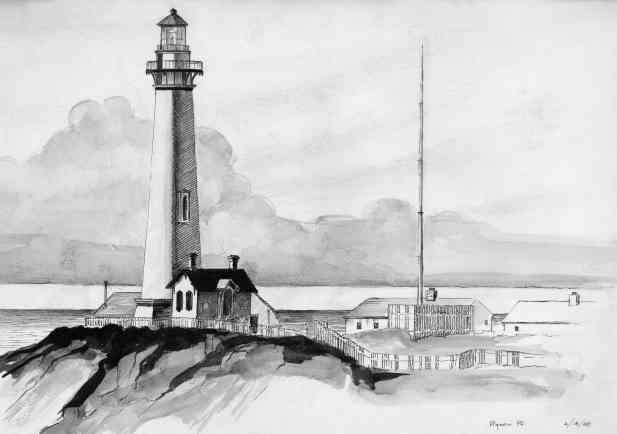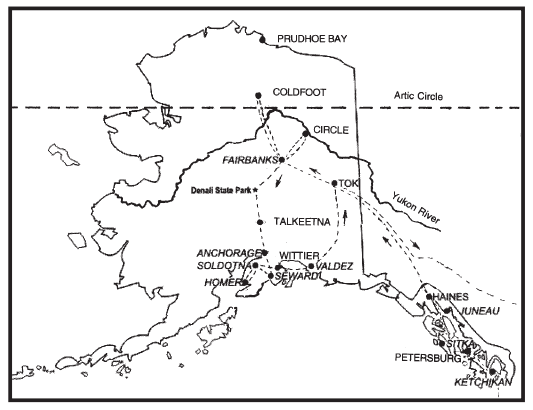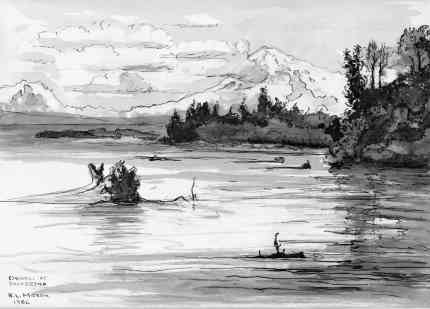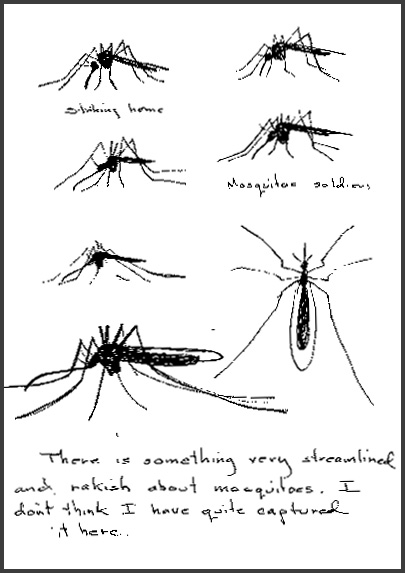To the Sun and Back: An Alaskan Pilgrimage
10. The Battle of Moon Lake
The Battle of Moon Lake
June 8th found me at Moon Lake Wayside, near Tok, Alaska. I was finally getting into what Alaskans call “the interior” and many consider it the “real” Alaska. At 60 degrees N. it is about the same latitude as Oslo, Norway. It was a remote location, I couldn’t get a single station on the van’s radio, AM or FM.
It was quite warm, T-shirt weather, and the mosquitoes were out in force. There seemed to be more of them than in Southeast Alaska and they were hungrier. I put mosquito repellent on my list as a must for the next shopping stop. Thank goodness my van had screened windows, otherwise I would have been eaten alive.
At this point it didn’t get dark at all. There was an evening twilight that gradually turned into a morning twilight, and then another day began. It was hard to make yourself hit the sack when at 10:30 p.m. it looked like 5:30 p.m. outside. I had to laugh when I thought of all the ways I had planned to provide my own light:
the van’s DC system,
an AC light for when AC was available,
a battery operated lantern,
a propane lantern,
a kerosene lantern,
candles,
two flashlights,
and I didn’t need any of them! The Sun was doing an interesting number on both Georgia and me. However, logic, if nothing else, told me that eventually I must sleep. So at what seemed an appropriate time by my wrist watch, I entered my mosquito shelter and tried.
Moon Lake was a very pleasant spot, and interesting, with float planes taking off and landing right past my camping site. It was also free as are all State campgrounds in Alaska. I decided to stay two days.
“Damn! That’s the fourth one in a row!”
My van seemed to have sprung a mosquito leak. At first I thought they were just a few that got closed in when the door was shut. Every time I opened the door a few always got in, but this seemed like too many! They came at me one at a time. They waited until I was almost asleep then one would show up with its characteristic hummmm. It seemed as if they found some devious and obscure little entry and they were lined up there waiting to crawl through in single file.
I finally got up in the middle of the so-called night to see if I could spot their trick. The screens were covered with mosquitoes milling about like a convention of some industrial association debating how to gain entry to this vast new market. I really couldn’t see that they were making any progress in their deliberations. The answer must have been struck upon in some subcommittee and the news hadn’t hit the convention floor yet.
“Well, thank goodness for that!”
I really wasn’t getting bitten much because being rather large mosquitoes they were noisy and since it wasn’t dark they were sitting ducks for a well aimed slap. They were, however, fearless in their attack. Again and again they charged with fixed bayonets. Again and again my anti-aircraft knocked them out of the skies. As far as I could tell, I was winning the battle, but I wasn’t getting any sleep either. Their strategy became apparent. They would lose all the battles but win the war. Suddenly there were more. The subcommittee must have made its report to the full convention.
“And thick and fast they came at last
and more and more and more.”
Lewis Carrol, from The Walrus and the Carpenter
Finally, just when it looked like my fate was to be sucked dry, a miracle! A strong breeze sprang up accompanied by rain. The mosquito forces broke off their attack. With a sigh of relief, I drifted off to sleep.
I can almost feel sorry for them in a way. There are so many of them and so few of us to bite. I’m sure that many are born, live briefly, and die without ever getting a single meal. No wonder they are so voracious.
It’s interesting that we use the Spanish word almost exclusively to name these pests. In Spanish “mosca” is “fly” so “mosquito” is “little fly.” I couldn’t even think of the English equivalent, but Webster told me the English word is “midge.” I guess I had heard that.
Even Georgia was subject to mosquito attacks. They couldn’t get to her except where her fur was short around her face and ears. She walked around with a little cloud of mosquitoes dancing in front of her eyes. It reminded me of that character from Li’l Abner who always had a little cloud right above his head that rained in his face all the time. Georgia took a number out of action with a quick snap of her jaws. She also swung at them with her paws, but didn’t get good results that way.
In the morning I surveyed the battlefield. The dead soldiers of the mosquito army lay all about me. They were contorted into grotesque positions, evidence of agonizing deaths. A few still twitched now and then. An examination of my body revealed that their efforts hadn’t been entirely in vain. A few brave individuals got one last meal off an exposed extremity before they went off to mosquito heaven.
Then I made a telling discovery. The passenger’s side door was not closed completely! Human error strikes again!
Epilogue
Finishing this writing project twenty years after I first started has been an instructive experience. The journey came alive for me once again. Rereading what I had put down originally, and going back through the daily log that I kept at the time reinforced the common belief that your memory serves you best for the good parts and the bad parts fade. I am sometimes asked if I was lonely. The answer is yes. I knew, for me, loneliness, or “aloneness,” was conducive to creativity. I think this is especially true for writing. I have a good tolerance for interruption when working on an art project, but for writing, I need blocks of dedicated time. On the trip I was most productive when I was the loneliest. The solitude was deepened by the fact that the trip took place during a hiatus in my relationship with partner Evie Wilson, but I am happy to report this came to an end upon my return. Our partnership in life is still going strong as this project is completed. One other relationship that has endured is the one with my old friend and companion the van which is now closing in on 200,000 miles. And, of course there is our Sun, the home star. As for Georgia, she will live on in this book. It is apparent to me now that this journey was a time of introspection and self-examination on several levels, and I believe that I benefited from the process. It may not work for everyone, but the pilgrimage to Gobblers Knob to watch the Sun make a big circle in the sky helped me with a number of perspectives not all of which made it into this book. I shall always treasure them.
The essays that originally constituted Part II of this book may be found here.
Prologue
The stretch of coast between Half Moon Bay and Point Año Nuevo, California is one of my favorite settings. In total, it is perhaps only twenty miles or so and includes the villages of San Gregorio and Pescadero.
While driving south from Half Moon Bay, on the left is rolling agricultural land and on the right a view of surf, cliffs, and rocks. Highway One becomes an ecotone between pastoral and marine. Looking out to the horizon you can often see ships, fishing boats, and occasionally the spout of a gray whale as it migrates north or south along the coast. About half way between Pescadero and Año Nuevo is Pigeon Point which is graced by a lighthouse straight from a picture book.

Lighthouse at Pigeon Point
Pigeon Point was my destination early in the spring of 1986, as it had been many times before. It is a truly magical spot and it’s my favorite place to watch the Sun set. As I drove south in the late afternoon light, I was once again struck by the beauty of the area. All the hills were green with spring, and fleecy clouds left over from a late season storm were blowing in from the horizon. Row upon row of artichokes flashed by to my left while cattle and sheep could be seen grazing on the hills in the distance.
Since Pigeon Point is only an hour’s drive from Palo Alto, I often went there when I needed a break in my daily routine. It has the advantage of being close while seeming far away. As the light fades, the sound of surf predominates along with the flash of the beacon at the lighthouse. One could, at that time, park right on the edge of the cliff and look down about 40 feet to the surf dashing against the rocks below. Low tide reveals a plethora of tide pools. At night the lights of the fishing boats are stippled along the horizon and, when the moon is not out, the milky way is plainly visible. You sleep to the primal rhythm of the surf. Eternal . . . eternal . . . eternal; the sound of the surf is one of only a few sounds I can think of that connect us so directly with the eternal.
Upon arriving that evening in 1986, I settled down with a glass of wine just north of the lighthouse. As I watched the Sun slip out of sight, I wondered if I would find a spot to match this during my trip north. Maybe, and what else would I find . . .

Alaska Travel Route

Introduction
Starting in May of 1986, I took a year off from my regular position as Artist-in-Residence for the Pacific Art League in Palo Alto, California. Having hired and trained an assistant to run my framing business, I intended to take a sabbatical and see some of the United States. Two fine books, Travels with Charlie by John Steinbeck and Blue Highways by William Least Heat Moon, helped inspire my decision to make such a trip. In addition, I wanted to sort out some philosophical thoughts I had been mulling over in my mind for a number of years. Such a trip would provide the opportunity. To begin my wanderings, I decided the first leg should go as far north as possible and that led me to Alaska. This book chronicles that journey.

Denali at Talkeetna by R L Mason
Somewhere I had heard of the Japanese custom of keeping a “legacy,” a large book in which the head of a family wrote down his thoughts on life and other matters. The book was passed down through the generations with each successor adding his own thoughts. This practice appealed to me since I was curious about my ancestors and yet knew so little about them. Also, I was fascinated with the enduring nature of books. I had read the Autobiography of Benvenuto Cellini and the Travels of Marco Polo. I marveled at how a book could provide a direct communications link between people of different times. Both authors were able to speak directly to my mind from their minds over periods of five and seven hundred years. It amused me to envision my descendants smiling at my quaint expressions five hundred years from now.
Age fifty (almost) seemed like an appropriate time of life to start such a project. At that age you are still young enough to have all your wits about you, yet old enough to have had a fair amount of experience with the world. You should have lost a good deal of naiveté and gained objectivity. You should have a pretty good handle on which of those “lessons” you were taught as a youth were sound and which didn’t hold water. You may even have a fresh insight, or rarer still, an original thought.
You have to have something of an ego, of course, to even attempt such a project, but low self-esteem has never been a problem of mine. On the other hand, I have no illusions about changing the course of history with this book. If it is never
read by anyone other than my daughter and granddaughter, that will be enough. I did feel a nagging sense of obligation and I think this springs from a vague notion that a life should somehow “bear fruit;” that something in addition to progeny should be left behind at the end. Being an artist has helped fulfill this need, but a work of art lacks the specificity of the written word, and I wanted to be more specific.
I don’t pretend to be an expert on any of the subjects and disciplines that are touched on in this book. The only subject I claim expertise for is my own opinion, and the reader will soon discover that I have opinions. Prefacing every personal conclusion with “it seems to me” or “as I understand it” does get rather tiresome, so I ask that the reader plug these words in mentally whenever I begin to sound instructive. They are, after all, only opinions. Finally, I have decided even though this book is a personal project, I might as well do it in a finished manner. At least I should try for broad appeal, although I would consider broad readership a bonus. An account of my trip provides the structure for introducing a number of diverse thoughts and is also a story in its own right. Much of this book was drafted at that time. Upon returning, however, and reengaging in the process of making a living, the project languished. I was determined to complete the project upon retirement, and did so with the help of a daily log which I kept on the trip, as well as photographs, tape recordings, and sketches done on location.
The essays that originally constituted Part II of the book may be found here.
Categories
- THE GALLERY
- Uncle Rob's Art
- 3D Works (stills) I
- 3D Works (stills) II
- 3D Works (stills) III
- 3D Works (video)
- Design & Abstract I
- Design & Abstract II
- Design & Abstract III
- Figurative Works I
- Figurative Works II
- Landscapes I
- Landscapes II
- Largest Art Project
- Nautical and Marine Images (video)
- Nautical and Marine Images I
- Nautical and Marine Images II
- Nautical and Marine Images III
- Nautical and Marine Images IV
- Portraits
- Still Life Images
- Stump Hollow Photo Essay I
- Stump Hollow Photo Essay II
- Uncle Rob's Mendocino Shop
- The Five Sense Series
- Irene's Creations
- Works by Don Mason
- Works by Don Mason II
- Works by Joseph de Borde
- Painting by Albert Robbins
- Art by Leslie Masters Villani
- Paintings by Nellie Harriet Parker
- The Art of Bee Yearian
- Works by Evie Wilson
- Uncle Rob's Art
- SCHOONER MOON BOOKS
- SEA STORIES
- ONE DOZEN AND TWO ESSAYS
- Cousinhood
- Art by Definition
- Cake Mixed Economy
- Marriage Anyone?
- Sex and/or Violence
- Searching for Truth
- The Philosophical Roots of Science
- Stepping Stones and Stumbling Blocks
- On Being Good
- Teaching By Example
- The Basic Law of Civilization
- Where Goeth Evil?
- A Modern Empircal "Religion"
- Knowledge as Wealth
- PAPERS AND ARTICLES
- FAMILY STORIES
- BOOK REVIEWS
Archive
- December 2021
- October 2020
- June 2020
- September 2019
- July 2017
- March 2017
- December 2016
- November 2016
- October 2016
- August 2016
- July 2016
- June 2016
- May 2016
- March 2016
- February 2016
- February 2015
- January 2015
- February 2014
- December 2013
- November 2013
- August 2013
- June 2013
- August 2012
- July 2012
- April 2012
- March 2012
- February 2012
- November 2011
- September 2011
- June 2011
- May 2011
- April 2011
- March 2011
- February 2011
- January 2011
- December 2010
- November 2010
- October 2010
- September 2010
- August 2010
- July 2010
- June 2010
- May 2010
- April 2010
- March 2010
- February 2010
- January 2010
- December 2009
- November 2009
- October 2009
- September 2009
- August 2009
- July 2009
- June 2009
- May 2009
- April 2009
- March 2009
- February 2009
- January 2009
- December 2008
- November 2008
- October 2008
- September 2008

